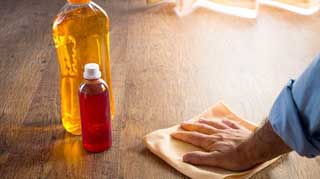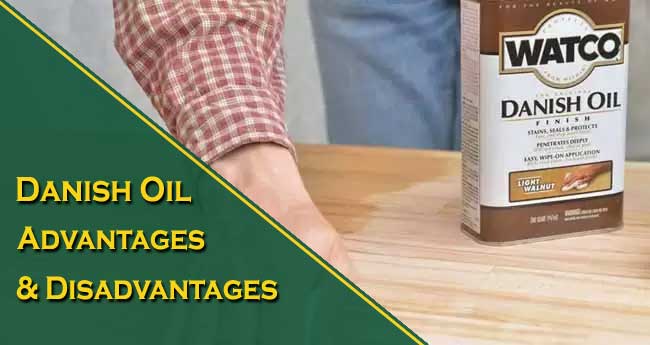Do you want to give your furniture the best final look to enhance its appearance and to completely secure its surface? Probably you have searched the web gives the best final look to your furniture and had heard about danish oil.
If you are not yet fully satisfied with your search research, do not worry!
We will help you get all the information about all the danish oil advantages and disadvantages and how to apply it with detail!
Wood treatment is very important for your woods because, without it, your wood strength can decrease. A non-treated wood will be making it possible to break and also revealing it to moisture.
Danish oil is for finishing because it consists of a high proportion of natural oil. This high proportion makes it a good drying oil. You might be thinking why this natural oil is good for woods?
A natural oil in danish will help with curing, wood will not get oily and will remain dry. Non-drying oils will make your wood to rot over time.
The best thing is, it will always bring out the expected beauty of your furniture!
Other benefits of Danish oil are it provides strong resistance against any kind of chemical reaction, guards your wood against scratches, and does not change its color over time. It also guards you against any heat and all types of stains.
A few steps are required and three coating layers. If you have recently started a woodworking project and don’t’ know a lot of wood finishing, we will recommend this one.
Let’s discuss the advantages and disadvantages of Danish oil in detail!
What is Danish Oil Used For?
Danish oil is for all woods including Teak wood, plum, pear, walnut, willow, totara, Sapele, and many other planks of wood. It is also used mainly for boat, bow and arrowwood, kitchenware, and boxes woods!
Before applying to make sure that sanding is completed and your surface of the wood is smooth. Remove all the dust from its surface. You can also use a tack cloth to remove any micro particles of dust.
To avoid any frustration, always start your work, where the environment is dust-free and peaceful. Other than that, the place should be properly ventilated having room temperature.
Apply your first coat by using a piece of cloth or any applicator. Leave your wood for 30 minutes. After that, reapply the danish finish. Make sure that the first layer has already been absorbed into the wood. You can also add layers until you get satisfied! More layers will make your surface even.
Always touch the surface with your fingertips to make sure it is dry and smooth!
After all the work disposes of your rag properly and carefully. Because if you will not dispose of it the proper way, the result can be unexpectedly combusted. Just hang it and wait for it to dry. Then after it is cured by becoming hard, throw it away!
Danish Oil Ingredients
Danish oil has different recipes. However, the main components are the same for this oil: Tung oil and linseed oil.
Linseed oil is obtained from a Flax plant. Linseed oil has gained popularity as a nutritional supplement. It is a multipurpose oil and provides Linolenic acid (an omega 3 fatty acid). When used with a wood oil after polymerization, it soaks into very small yet visible pores of the wood.
Tung oil and its name originated from China. It comes from the seeds of a tree that are named the same. With Danish wood oil, it provides strong protection to wood and under the sun it gets hard, and applying multiple layers of tung oil can make a plank of wood look brighter and more glowing.
In the beginning, this oil was majorly used for making water-proof ships. It also appears in the work of Chinese old philosopher, Confucius.
Other ingredients in Danish oil can be mineral oil, aromatic Petroleum Distillates, and Stoddard solvents. It can be a mixture of some of these depending on its brand.
Advantages of the Danish Oil
Sure, we all want our home and other spaces to be decorated with better-looking wooden furniture that can last longer without requiring frequent repairs. But the question comes how to choose a cost-effective wood finishing.
1. Water-Resistant
Danish oil coating is resistant to water and liquids. As its particles contain the characters of polymerization, it provides a solid texture upon drying.
Danish oil is known as a hard-drying oil because when its particles react with oxygen in the atmosphere, they are polymerized into a solid layer.
2. Enhances the Sheen
Because of its property of absorbing into woods, Danish finishing protects a wood not form just outside but it also strongly guards a wood against the inside. It nourishes and gives a wood treatment from inside. This property of danish oil gives an extra touch to the beauty and appearance of wood.
It always provides a very good-looking low sheen in the end. It also enhances your wood beauty by making it look darker. Providing resistance against any chemical reaction and heat also makes your wood to remain glowing.
3. Easy Application
Danish finishing is very convenient. You have already become familiar with how its application work.
Few more things that you need to know are that always apply this oil in the direction of the grain of your wood and apply at least 3 coatings for excellent sheen.
Don’t forget to touch the surface before applying on another coat to make sure that the surface is smooth and completely dry. You can also add more than 3 layers for more glow depending on the wood and the brand you are using.
4. Elastic
Don’t be surprised about the elasticity of danish oil. It indeed becomes hard after polymerization but yet it has the wonderful property of being elastic.
Suppose your wood expands or contracts due to any reason, it will not affect your finishing because of elastic property. The oil finish will also expand with your wood.
By using danish oil, you will not find any scratches on your wood or a dull spot because of wood expanding!
5. Kitchen safe
It is indeed very safe for kitchen items but you have to be careful about selecting the brand and always check the materials. We have already mentioned the two-best food-safe danish finish brands.
Depending on various brands, it also comes with different chemicals or a mixture of them. So, they can contain toxic chemicals and if used in kitchenware, they can cause a serious health issue.
6. Used as a Primer
It has also an advantage of using it as a primer. A Danish oil primer can be used on bare wood before exposing it to any kind of paint. It will increase the efficiency of your paint and it will not allow your paint to get damaged.
It will ensure better quality adhesion by physically and chemically bonding your paint to the surface.
Danish Oil Disadvantages

No doubt! There are many advantages of using danish oil but there are also some drawbacks. Disadvantages are not much of a negative thing but you have to be aware of them. We will be discussing each of them in detail.
1. Time-consuming
Giving your wood a danish finish requires a lot of patience while working. It takes up a lot of time. The reason is while using danish oil a sanding has to be done before every coating and average drying time for each coat can be 3-4 days.
Drying completely depends on which type of danish oil are you using. Forgiving a good look to your wood, it is recommended to use at least 4-5 layers of coating.
You also have to be aware of its thickness. The thicker layer will dry slowly and can end up with a disaster. We suggest you do a coat in thin layers while using danish oil.
2. Regular Maintenance
A big drawback of using Danish oil is that it requires consistent and careful protection. This maintenance requires cleaning of the wood for the appearance of your wood. It also includes the refreshment of your wood using the same finish oil.
The main concern is that you will require its periodic maintenance because it can easily collect dust particles. If not cleaned properly on time, your wood can lose its shine over time!
3. Less Durability
Danish oil doesn’t make a very good durable finish. Compared to much other oil, its durability percentage is very low. Durability rate also affects its resistance strength against the dirt and can become easily scratched over time.
It is also less protective as compared to other finishes like paint or varnish which can be a better choice for some specific objects that we use more in our daily life.
Danish finish collects dust particles in the environment faster and thus require you to clean your woods regularly.
As there are different brands for danish finish and the percentage of the chemical components in them are different, we can say that it can be toxic and can damage wood to a certain level.
That’s why it is suggested to know the ingredients in your oil finish before starting to work with it.
4. Limited Application And Efficiency
You can only apply danish oil to bare woods. No doubt It will do wonders on untreated and new wood surfaces. But its usage is limited to that.
Because of this oil wide usage and varieties, it is very unpredictable how it will affect your wood. For example, if you are expecting a certain color on your wood, you are always required to test it first for the desired results.
It is also very difficult to apply when using porous woods. because it is easily absorbable, it gets into that pores and cracks happen. Well, you just have to be more careful while using it on porous wood.
5. Spontaneous Combustion
It is obvious that when exposed to air, danish oil becomes hard and it is an advantage rather than a disadvantage. But what about an exothermic reaction? Yes! An exothermic reaction can result in fire. So, to avoid that you have to very careful with the rags you are using.
An oily rag can explode and make a fire. You have to make it hard by either soaking it in a water tub or just dry it by placing it flat on the surface. After that, discard it.
Is Danish Oil Food Safe?

What about food safety while using this particular oil? Or have you ever questioned is it ok if I give a Danish oil finish to cutting boards, salad bowls, or any other kitchenware?
The answer is yes! A completely cured Danish oil is completely safe for your kitchen wood furniture or wooden cutting boards. Danish oils always make a strong bonding with the wood surface and don’t do any reactions with food substances. It remains still making it safe for food items that we use for eating.
It is very secure because it is considered among hard drying oils means it converts into solid form through polymerization. Polymerization is a simple process of curing any finished oil. It turns liquid form of finish to a hard-solid form.
We can think of it as a cross-linking process. A whole lot of single molecules go through a chemical reaction and get connected, that is polymerization!
The most common reaction for polymerization is oxidation. When oxygen enters the finish, it causes molecules to attach or make a cross-chain with each other.
There are different brands for danish oil that it is very difficult to choose one for your woods!
Now, We will discuss two main brands that are food safe:
1. Watco Danish Oil Finish
It has an excellent wood penetration power and provides strong resistance against moisture. This oil-based blend gives your wood a very professional look and enriches its grain!
It has very good durability and has multiple functions. This product has the long-lasting quality and secures your wood from cracking and leaking. With it, you can always add beauty to your old and forgotten wood furniture in your home. Another good thing about this finish is that it gives a new life to a bronze.
2. Tried & True Danish Oil Finish
This finish is very economical and provides coverage of around 600 square feet every gallon! It gives your wood a very flat and glossy touch because of fairly polymerized linseed oil in it.
Tried and True Danish oil is highly recommended for all kitchenware including cutting boards. It is also good for children’s furniture. Because of its non-toxic nature, the FDA has approved this finish for every type of wood surface that is used in the kitchen.
Keep in mind that before buffing you have to wait 5 minutes and then apply a coat. Before applying another coat, wait for 8 hours!
Frequently Asked Questions
1. What Quantity is Used For a Good Thin Coat?
Answer: We will recommend you to use make a layer as thin as you can. To make it more effective, try to use it from the center of the wood and then applying it to the corners.
2. Is Ventilation Important While Applying Danish Oil?
Answer: It is always suggested to work in an environment with proper ventilation and always prefer a dust-free environment. Because without any ventilation system, the smell can bother your work.
3. Have Used Too Much Oil And Wood Is Not Getting Dry?
Answer: Do not worry about it! The dry time is always unpredictable depending on your wood. The possibility is that your wood is more porous and taking more quantity of danish. If it’s not the case then try to wipe off all the extra finish on your wood surface by applying maximum effort to make a wood cure. Always remember to apply a very thin layer!
Conclusion
Based on the danish oil advantages and disadvantages, we will recommend it to use in new woods and where all conditions are suitable. It is obvious that it produces a very good result for a wood finishing and makes your wood look more enriched.
Its penetration power is strong and safe to use for children’s furniture It is very economical as well as have very easily applying process.
Try some of it before applying to the wood surface. Being careful will save you from a bad result and a disaster!
We wish you all the best and hope that you will get your desired results while using danish oil!
Few more similar topics you might want to read:
- What are the Advantages & Disadvantages of Tung Oil & Danish Oil?
- How to get rid of Stain Oil From Your Wood?

